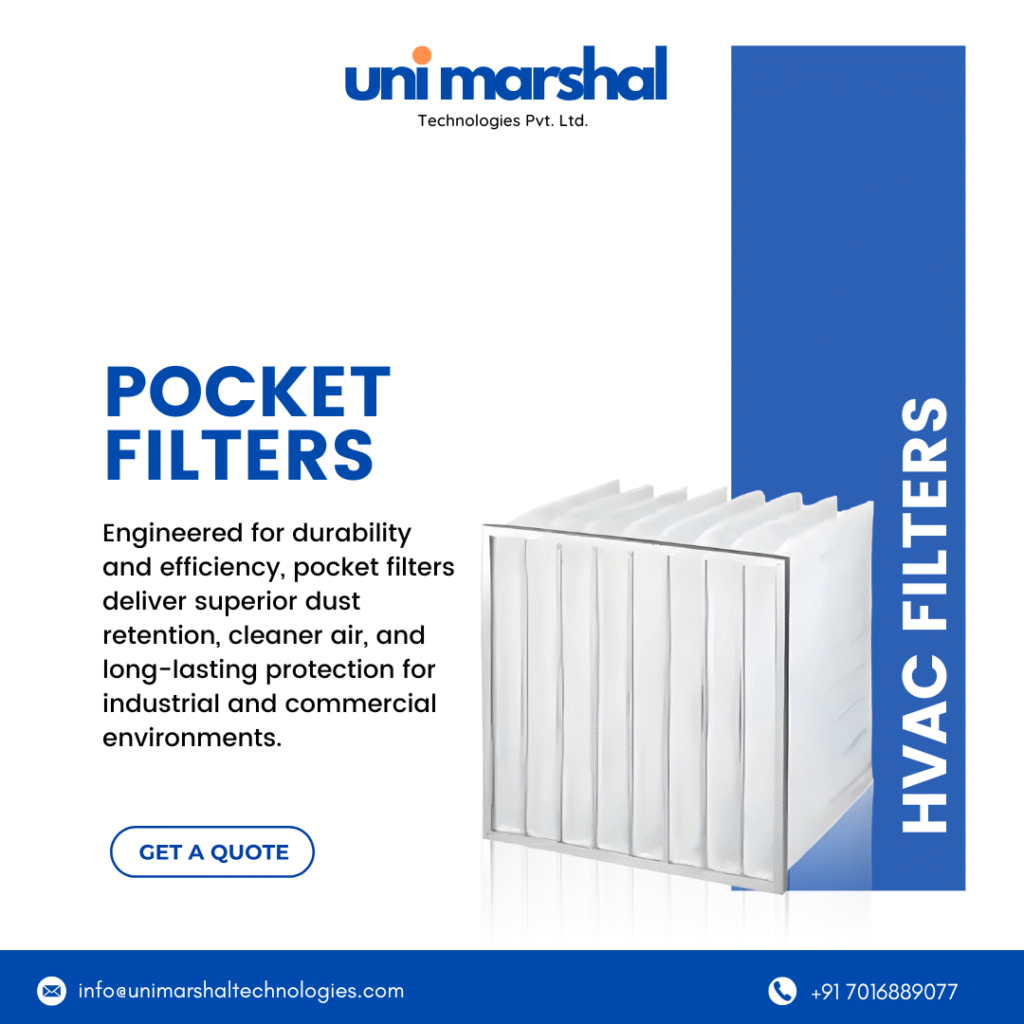Table of Contents
Introduction
Indoor air quality has become a critical concern for industries, offices, hospitals, and commercial spaces. With rising pollution levels and strict safety regulations, HVAC systems require effective filtration to keep air clean and equipment efficient.
Among the many filtration technologies available, pocket filters (also known as bag filters) have proven to be one of the most reliable, durable, and cost-effective solutions. They serve as medium-to-high efficiency filters, often used as pre-filters to protect expensive HEPA and ULPA filters in advanced systems.
What Are Pocket Filters?
Pocket filters are multi-pocket air filters designed to capture dust, pollen, fibers, spores, and other airborne particles. Their unique design features multiple extended “pockets” or bags made from synthetic fiber or fiberglass media, providing a large filtration area within a compact frame.
These filters are typically installed in the secondary stage of HVAC systems—after coarse pre-filters and before high-efficiency particulate filters like HEPA.
Construction of Pocket Filters
A typical pocket filter consists of:
- Filter Media – Synthetic, melt-blown, or glass fiber with progressive density for particle capture.
- Pockets/Bags – Stitched or welded media bags arranged in parallel to maximize surface area.
- Frame – Galvanized steel, aluminum, or plastic housing to maintain rigidity.
- Airflow Design – Optimized pleating or pocket arrangement ensures low pressure drop and uniform airflow.
This design ensures high dust holding capacity while maintaining consistent efficiency throughout the filter’s life cycle.
How Do Pocket Filters Work?
Pocket filters use a depth-loading filtration mechanism.
- Stage 1: Larger particles are trapped on the surface of the media.
- Stage 2: Smaller particles penetrate deeper and are captured within the fibers.
- Stage 3: Fine particles are held in the inner layers, maximizing dust retention.
The multi-pocket structure distributes air evenly, preventing blockages and allowing more dust to be stored before replacement is needed.
7 Benefits of Pocket Filters in HVAC Systems
- Superior Air Quality
Pocket filters capture up to 90–95% of airborne particles, significantly improving indoor air quality for workers, patients, and equipment. - Extended HEPA Filter Life
Acting as pre-filters, they reduce the load on costly HEPA filters, lowering replacement frequency and operating costs. - Energy Efficiency
Designed for low pressure drop, pocket filters allow HVAC systems to maintain efficient airflow and reduce power consumption. - High Dust Holding Capacity
Their deep pockets can store large amounts of dust without frequent clogging, making them ideal for dusty industrial environments. - Durability and Moisture Resistance
Synthetic pocket filters are resistant to humidity and microbial growth, ensuring stable performance in varying conditions. - Versatility in Applications
Available in various efficiency classes (F5–F9, ISO ePM10–ePM1), they are adaptable to different industries and filtration needs. - Cost-Effective Maintenance
Fewer replacements and reduced strain on HVAC equipment mean lower operational costs over time.
Applications of Pocket Filters
Pocket filters are widely used in:
- Hospitals & Healthcare – Prevent airborne contaminants and protect patients.
- Pharmaceutical Manufacturing – Maintain sterile environments.
- Food & Beverage Industry – Ensure hygienic air quality in processing units.
- Commercial Buildings – Improve comfort in malls, offices, hotels, and airports.
- Industrial Plants – Manage high dust loads in cement, steel, and textile factories.
- Cleanrooms & Laboratories – Serve as pre-filtration before HEPA/ULPA systems.
Choosing the Right Pocket Filter
When selecting a pocket filter, consider:
- Efficiency Class – Match with application (F5–F9 or ISO 16890 grades).
- Dust Load Capacity – Higher capacity for dusty industrial environments.
- Moisture Resistance – Synthetic media for humid or microbial-prone conditions.
- Frame Material – Steel or aluminum for durability, plastic for lightweight systems.
- Airflow & Pressure Drop – Ensure compatibility with existing HVAC fans.
Conclusion
Pocket filters are indispensable components of modern HVAC systems. With their high dust-holding capacity, energy efficiency, and ability to extend HEPA filter life, they provide a balanced solution for both industrial and commercial air quality needs.
By investing in quality pocket filters, industries can not only achieve regulatory compliance but also create healthier, more efficient, and cost-effective environments.
At Unimarshal Technologies Pvt. Ltd., we specialize in manufacturing and exporting high-performance pocket filters designed for diverse industrial applications. With a strong focus on quality, innovation, and global standards, we are your trusted partner in air filtration.
Pocket Filters for Global Export
As part of our export division, Unimarshal Technologies supplies pocket filters to markets across America, Europe, the Middle East, Africa, and Asia-Pacific. Our filters are designed to meet international HVAC standards (ISO 16890, EN 779, ASHRAE 52.2), ensuring compatibility with global systems. With reliable packaging, timely delivery, and competitive pricing, we support OEMs, distributors, and end-users worldwide who seek durable and efficient air filtration solutions. Whether you are a contractor, HVAC system integrator, or industrial buyer, our team ensures seamless support for your global air filtration requirements.


